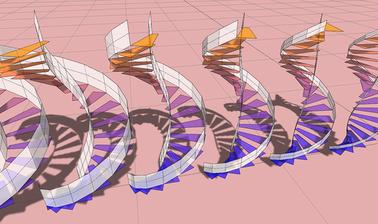MOOC List is learner-supported. When you buy through links on our site, we may earn an affiliate commission.

MOOC List is learner-supported. When you buy through links on our site, we may earn an affiliate commission.
The first in our “Spatial Computational Thinking” program, this “Procedural Modelling” course will focus on the fundamentals of procedural programming in 3D. You’ll learn to write computational procedures using data structures and control-flow statements to automate the production of 3D models.
During the course, you will learn a range of computational methods. These include general programming constructs such as using ‘while’ loops, ‘for-each’ loops, ‘if-else’ conditions, as well as writing your own custom functions. In addition, you will also learn to use two key data structures: list and dictionaries. And in the process, you will become familiar with the programming process: writing code, executing code, and debugging code.
When creating modelling procedures, you will use a range of different modelling functions. You will also learn how geometric models can be augmented with an additional layer of semantic data. You will learn how geometric entities can be tagged with additional attribute values, and how these attributes can then be used for querying your models. You will also learn how to add attributes to define color, materials, and other visual properties.
During this course, you will use Möbius Modeller, the modelling tool that is used throughout this “Spatial Computational Thinking” module. It is free and easy to use browser-based software to write algorithms for automatic generation and visualization of complex models with spatial information.
The programming language uses a visual programming approach combining flowcharts with procedural programming. This makes the process of learning coding much easier, allowing you to quickly acquire the knowledge and skills required for writing complex computational procedures for generating, analysing, and visualizing complex 3D spatial information models. The programming knowledge you gain will be highly transferable if you later choose to use other languages in your future work such as Python or Javascript.
The modelling exercises and assignments during this course will start with a simple procedural approach to 2D and 3D patterns and will progress towards more complex geometries representing entities within the built environment such as building footprints, building facades, and staircases.
The course prepares you for the next course in the “Spatial Computational Thinking” program , focusing on generative modelling of more complex types of spatial information models.
What you'll learn
Learning algorithmic thinking:
* What is Spatial Computational Thinking?
* The fundamentals of procedural programming
* How procedures can be used to manipulate spatial information models
* An understanding of the coding process: write, execute, and debug
* How semantics can be used to augment geometric models
* The difference between geometry, topology, and attributes
* How query languages can be used to extract data from models
Learning procedural modelling:
* Fundamentals of geometric objects: points, polyline and polygons
* Using modelling functions for creating and modifying geometric objects
* Managing connectivity between geometric objects
* Modelling with geometry, topology, and collections
* Attaching attribute data to geometry, topology, and collections
* Querying and filtering data in the model using attributes
Learning coding:
* Coding using an Integrated Development Environment (IDE)
* Fundamentals of variables and simple data types
* Fundamentals of operators: assignment, arithmetic, relational, logical
* Fundamentals of programming with libraries of functions
* An introduction to the list and dictionary data structures
* Understanding function parameters, arguments and return values
* Manipulating control flow using ‘while loops’, ‘for loops’ and ‘if conditions’
* Understanding variable assignment and variable scope
* Creating custom local functions to avoid repetitive code
* Strategies for writing and debugging code
Learning Möbius Modeller
* Overview of Möbius Modeller as a development environment
* The Möbius Modeller user interface
* Creating computational flowcharts with parameters
* Working with the console and different type of viewers
* Creating flowcharts with multiple nodes and parameters
* Flowchart patterns, using in-series nodes or in-parallel nodes
* Strategies for communicating between nodes within a flowchart
* Submitting assignments using Möbius Modeller
MOOC List is learner-supported. When you buy through links on our site, we may earn an affiliate commission.
MOOC List is learner-supported. When you buy through links on our site, we may earn an affiliate commission.
